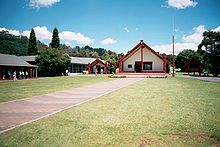- New Zealand Māori Arts and Crafts Institute
-
The New Zealand Māori Arts and Crafts Institute (NZMACI) opened in 1967 in Rotorua, New Zealand due to the impending threat of the loss of traditional Māori arts.[1] In 1926 a Māori Arts and Crafts school had been established in Rotorua by Sir Apirana Ngata, and the new school continued the tradition in a location well-established for traditional Māori arts and crafts. The location of school at Whakarewarewa enabled easy access to the lucrative tourist market, which continues to be a substantial source of sales.
Contents
The Institute
History
Founded in 1926 by Apirana Ngata, then the Member of Parliament for Eastern Maori which included Rotorua, the school focused on keeping teaching traditional Māori arts and crafts. The school was located near the geyser field at Whakarewarewa outside of Rotorua, an enduring tourist draw-card.
The Rotorua Maori Arts and Crafts Institute Act 1963 founded the school as a legal entity, and the act was amended by the New Zealand Maori Arts and Crafts Institute Amendment Act 1967 which changed it from a local to a national institute,[2] by removing most references to Rotorua. Since the spelling of Maori has changed to Māori as part of an effort to make the Māori language phonetic.
The Institute generally falls under the tourism portfolio and the Ministry of Economic Development, with the Minister of Tourism or an Associate Minister of Tourism making appointments to the board. Recent appointments have included: Robert McFarlane, Ani Waaka,[3] David Thomas, Sir Howard Morrison, June Grant, Judith Stanway, Ray Watson,[4] Erenora Puketapu-Hetet, Mike Simm, David Tapsell[5] Ken Raureti, Robyn Bargh and Tupara Morrison.[6]
Since the Māori Renaissance of the nineteen eighties and nineties, Māori traditions have had more impact on contemporary art in New Zealand, leading to a blurring of the lines between art and Māori art. The Institute exhibits at events such as Māori Art Market but it's teaching and output continue to focus on more traditional items.
The Institute was re-branded as Te Puia in 2005[7][8] and remains a significant tourist attraction in Rotorua.
Carving
A predominant artform of the Māori people is whakairo,[9] carving, referred to by some as the written language of the Māori.
The Carving school, Te Wānanga Whakairo Rakau, was opened in 1967 and has since restored and built over 40 whare whakairo around New Zealand. The first head of the Carving school was the late renowned Tohunga Whakairo (Master Carver), Hone Taiapa.
Weaving
The second artform perpetuated at NZMACI is raranga, weaving.
The Weaving school named Te Rito was established in 1969, shortly after the Carving school. The head of the school at the time was Emily Schuster, and it is now headed by her daughter, Edna Pahewa.
The combination of the two schools signified the renaissance of whakairo and raranga, many of the alumni of the schools went on to play roles in the Māori renaissance.
References
- ^ Metge, Joan. Rautahi: The Maoris of New Zealand. Routledge. p. 274.
- ^ "New Zealand Maori Arts and Crafts Institute Act 1963 No 51 (as at 03 September 2007), Public Act – New Zealand Legislation". legislation.govt.nz. 2011 [last update]. http://www.legislation.govt.nz/act/public/1963/0051/latest/whole.html?search=ts_act_Arts+and+Crafts+Institute_resel&p=1#dlm348783. Retrieved 16 October 2011. "The Long title was amended by section 2(4) of the New Zealand Maori Arts and Crafts Institute Amendment Act 1967 by substituting the words '“New Zealand”' for the word '“Rotorua”'."
- ^ "New Appointee To Maori Television Service". scoop.co.nz. 2006 [last update]. http://www.scoop.co.nz/stories/BU0203/S00043.htm. Retrieved 17 October 2011. "Te Putahi Paoho, the Mäori Electoral College, has announced the appointment of Ani Waaka to the board of the Maori Television Service, replacing former board member Joanna Paul."
- ^ "beehive.govt.nz - APPOINTMENTS TO MAORI ARTS & CRAFTS INSTITUTE". beehive.govt.nz. 2011 [last update]. http://www.beehive.govt.nz/release/appointments-maori-arts-amp-crafts-institute. Retrieved 16 October 2011. "Tourism Minister Lockwood Smith has announced new appointments to the Board of the New Zealand Maori Arts and Crafts Institute."
- ^ "beehive.govt.nz - Maori Arts and Crafts Institute Board appointments". beehive.govt.nz. 2011 [last update]. http://www.beehive.govt.nz/release/maori-arts-and-crafts-institute-board-appointments-0. Retrieved 16 October 2011. "Minister of Tourism Mark Burton Associate Minister of Tourism Dover Samuels today announced appointments to the Board of the Maori Arts and Crafts Institute (MACI)."
- ^ "beehive.govt.nz - MACI board members announced". beehive.govt.nz. 2011 [last update]. http://www.beehive.govt.nz/release/maci-board-members-announced. Retrieved 16 October 2011. "Associate Tourism Minister Jonathan Coleman today announced the appointment of three new members to the Maori Arts and Crafts Institute (MACI) board."
- ^ "Visit Te Puia at Rotorua for a unique blend of experiences". nzine.co.nz. 2011 [last update]. http://www.nzine.co.nz/features/tepuia.html. Retrieved 16 October 2011. "Te Puia is an umbrella brand with three sub-brands - the geothermal valley, Maori cultural experiences and the New Zealand Maori Arts and Crafts Institute."
- ^ "Te Puia Rotorua". tepuia.com. 2011 [last update]. http://www.tepuia.com/. Retrieved 16 October 2011.
- ^ Dunn, Michael (2002). New Zealand Sculpture: A History. Auckland University Press. p. 130. ISBN 9781869402778.
See also
External links
Categories:
Wikimedia Foundation. 2010.

